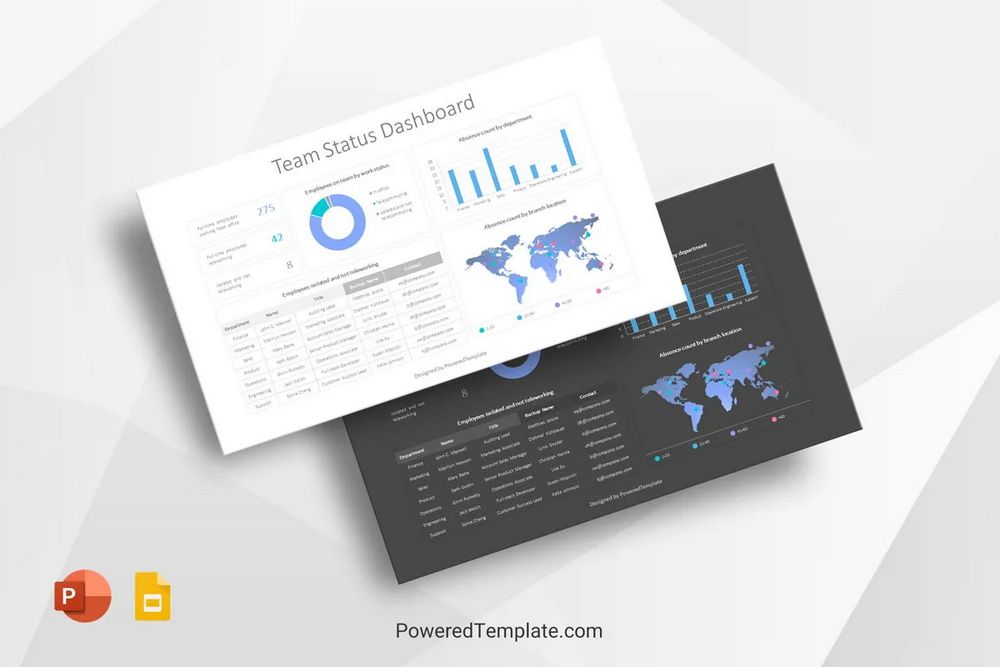By using CLEAR Goals premium and free templates you can create impressive presentation slides in minutes. In this article, we will explore CLEAR Goals as a methodology for setting effective and actionable goals and lists CLEAR Goals slides templates collected in the PoweredTemplate library.
Almost everyone knows the most famous acronym for goal setting, which is SMART. But it whether is enough for clear goal setting? What else may a leader use to become proficient in this?
What about adding some agility, as well as motivation and cooperation? Here goes CLEAR goal-setting!

CLEAR Goals is an acronym that stands for Collaborative, Limited, Emotional, Appreciable, and Refinable. This methodology provides a framework for creating goals that are clear, meaningful, and attainable.
Introduction to the CLEAR Goals Methodology
The CLEAR Goals methodology is designed to enhance goal-setting practices and improve the likelihood of achieving desired outcomes. It emphasizes the importance of clarity, collaboration, and adaptability in the goal-setting process. By incorporating these principles, individuals and teams can set goals that are motivating, focused, and adaptable to changing circumstances.
Collaborative Goals
Goals should inspire employees to work together collaboratively. Challenging goals serve as the primary support for self-development and motivation.
-
 Corporate 0.2 PowerPoint is perfect for your impressive style presentations and also flexible to corporate and business presentations. This Presentation Template, clean, creative, simple, unique, scalable and multipurpose.
Corporate 0.2 PowerPoint is perfect for your impressive style presentations and also flexible to corporate and business presentations. This Presentation Template, clean, creative, simple, unique, scalable and multipurpose. -
 Illustration of group of diverse people playing giant colored chess figures as a concept of 5 approaches, stages, steps, or phases to problem solving and finding a solution.
Illustration of group of diverse people playing giant colored chess figures as a concept of 5 approaches, stages, steps, or phases to problem solving and finding a solution. -
 Corporate 0.3 PowerPoint is perfect for your impressive style presentations and also flexible to corporate and business presentations. This template All elements are easily editable and customizable to your needs.
Corporate 0.3 PowerPoint is perfect for your impressive style presentations and also flexible to corporate and business presentations. This template All elements are easily editable and customizable to your needs.
Collaboration is a key aspect of the CLEAR Goals methodology. When setting goals, it is crucial to involve all relevant stakeholders and ensure their active participation. Collaborative goal-setting encourages shared responsibility, enhances commitment, and fosters a sense of ownership among team members. By involving others in the goal-setting process, diverse perspectives can be considered, leading to more well-rounded and effective goals.
Limited Goals
Goals should be limited in both scope and duration.
-
 Illustrative infographic template with constriction site, crane and workers building word “PLAN” as a plan creation business concept.
Illustrative infographic template with constriction site, crane and workers building word “PLAN” as a plan creation business concept. -
 Spectrum – Corporate Powerpoint Template. This is a Modern & Clean Powerpoint template, you can edit it with anything you want and for any purpose. This is suitable for Business Overview, Pitchdeck, Board Presentation, etc.
Spectrum – Corporate Powerpoint Template. This is a Modern & Clean Powerpoint template, you can edit it with anything you want and for any purpose. This is suitable for Business Overview, Pitchdeck, Board Presentation, etc. -
 Diagram with 4 converging arrows come together and form a big arrow as a business concept of teamwork, focusing on a goal and results with 4 forces, steps, stages, phases, options, or parts.
Diagram with 4 converging arrows come together and form a big arrow as a business concept of teamwork, focusing on a goal and results with 4 forces, steps, stages, phases, options, or parts.
Setting limited goals means defining goals that are specific and manageable. It is important to avoid setting goals that are too broad or vague, as they can be overwhelming and difficult to achieve. Limited goals are focused and clearly define what needs to be accomplished. By breaking down larger objectives into smaller, manageable tasks, individuals and teams can make steady progress and maintain a sense of accomplishment along the way.
Emotional Goals
Goals should make an emotional connection to employees, tapping into their energy and passion.
-
 Infographics with group of 6 colored arrows making an one big more powerful arrow, as a business concept of teamwork, synergy ideas, powerful cooperation with 6 steps, stages, parts, phases, or options.
Infographics with group of 6 colored arrows making an one big more powerful arrow, as a business concept of teamwork, synergy ideas, powerful cooperation with 6 steps, stages, parts, phases, or options. -
 The Teamwork template offers a professional look for your unique MS PowerPoint slideshows. It includes 20 masters in the standard 4:3 size, allowing you to choose the best layout for your information.
The Teamwork template offers a professional look for your unique MS PowerPoint slideshows. It includes 20 masters in the standard 4:3 size, allowing you to choose the best layout for your information. -
 Every successful team needs an inspiring, organized leader at its helm. Use this Team Leader Presentation Slide Template to impress your audience with an outstanding Team Leader PowerPoint slide template.
Every successful team needs an inspiring, organized leader at its helm. Use this Team Leader Presentation Slide Template to impress your audience with an outstanding Team Leader PowerPoint slide template.
Emotional goals recognize the importance of personal motivation and alignment with one’s values and aspirations. When setting goals, it is crucial to consider the emotional significance they hold for the individuals involved. Goals that evoke positive emotions, such as enthusiasm, passion, and a sense of purpose, are more likely to inspire sustained effort and dedication. Connecting goals to personal values and aspirations enhances intrinsic motivation and increases the likelihood of success.
Appreciable Goals
Goals should be suitable and proper, taking into consideration the business circumstances.
Appreciable goals emphasize the importance of measurable progress and milestones. By setting goals that can be quantified or objectively evaluated, individuals and teams can track their progress and assess their performance. Appreciable goals allow for regular check-ins and provide opportunities to celebrate achievements along the way. Breaking down goals into smaller, measurable components also makes them more manageable and less overwhelming.
Refinable Goals
The final aspect of the CLEAR Goals methodology is the emphasis on refinable goals. Set goals with a specific and powerful goal, but as new situations or information arise, allow yourself to refine and change your goals. Remember that we are agile!

Goals should not be set in stone but rather viewed as flexible and adaptable to changing circumstances. It is essential to regularly review and refine goals based on new information, feedback, and insights gained along the way. By embracing a continuous improvement mindset, individuals and teams can make necessary adjustments to ensure that goals remain relevant and aligned with their objectives.
Why a CLEAR goal-setting is important?
CLEAR goal-setting is important for several reasons:
- Clarity.
CLEAR goals provide clarity and focus. When goals are specific and well-defined, it becomes easier to understand what needs to be accomplished and how to proceed. Clear goals reduce ambiguity and confusion, enabling individuals and teams to align their efforts toward a common objective. - Alignment.
Involving stakeholders in the goal-setting process fosters collaboration and ensures alignment. When goals are set collaboratively, everyone has a chance to provide input and contribute to the decision-making process. This involvement increases ownership, commitment, and accountability, leading to better alignment among team members and increased chances of goal achievement. - Motivation.
CLEAR goals address the emotional aspect of goal-setting. By considering the emotional factors related to goals, such as personal interests, values, and aspirations, individuals can connect more deeply with their goals. This emotional connection enhances motivation, passion, and commitment, providing the drive needed to overcome obstacles and stay focused on the desired outcomes. - Measurability.
The appreciable aspect of CLEAR goals emphasizes measurability. When goals are measurable, progress can be tracked, and achievements can be celebrated. Measuring progress provides feedback on performance, highlights areas of improvement, and helps individuals and teams stay motivated by acknowledging their successes along the way. - Adaptability.
The refinable nature of CLEAR goals allows for flexibility and adaptation. Recognizing that goals may need to be adjusted or refined based on changing circumstances or new information enables individuals and teams to stay agile. Being open to refinements ensures that goals remain relevant and realistic, even in dynamic environments, and increases the likelihood of successful goal attainment.

In summary, CLEAR goal-setting brings clarity, alignment, motivation, measurability, and adaptability to the goal-setting process. By incorporating these elements, individuals and teams can set meaningful goals that are more likely to be achieved, leading to improved performance and outcomes.
Examples of CLEAR Goals
To illustrate the CLEAR Goals methodology, here are a few examples:
- Collaborative: “By the end of the quarter, the marketing team will collaborate with the sales team to develop a comprehensive marketing strategy that aligns with the sales goals and targets.”
- Limited: “Within the next month, I will complete three online courses to enhance my professional skills in project management.”
- Emotional: “By the end of the year, I will run a marathon to challenge myself physically and achieve a personal milestone.”
- Appreciable: “Within six months, our customer support team will decrease response time by 20% to improve customer satisfaction.”
- Refinable: “By the end of each sprint, the development team will review and refine project goals based on user feedback and emerging requirements.”
Conclusion
The CLEAR Goals methodology provides a practical framework for setting effective goals. By incorporating collaboration, setting limited and specific goals, recognizing the emotional significance, emphasizing measurability, and embracing adaptability, individuals and teams can enhance their goal-setting practices and improve their chances of success. By using the CLEAR Goals methodology, individuals and teams can create goals that are clear, meaningful, and attainable, leading to increased motivation, productivity, and achievement.

